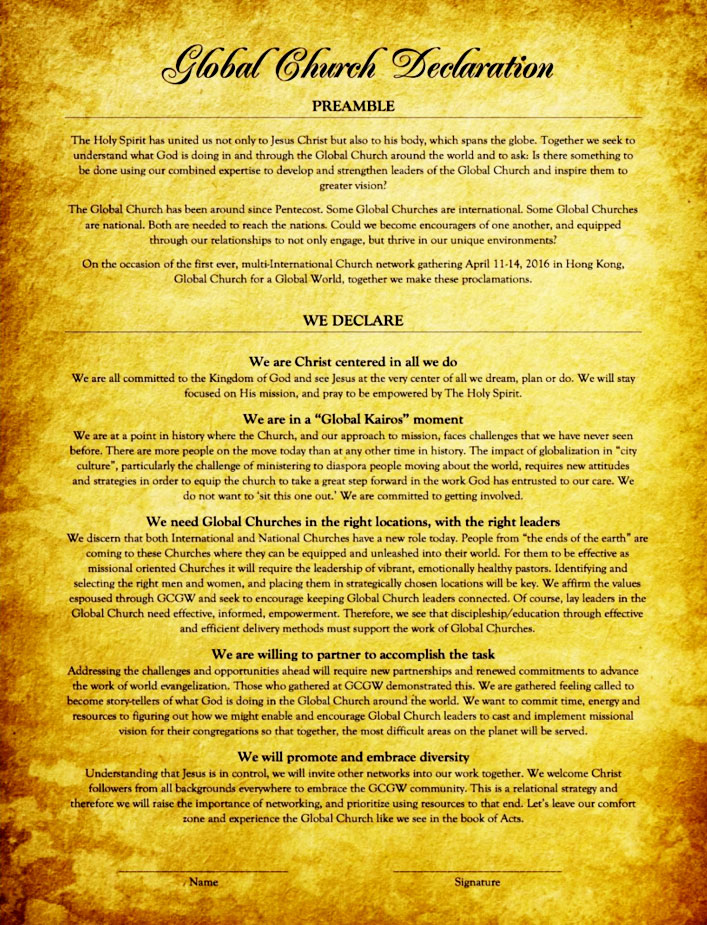The International Church is a kairos call to a profound need and compelling opportunity. God is sovereignly and supernaturally planting and building international churches in unparalleled numbers around the globe. The unprecedented diaspora scattering has created cutting-edge potential for the International Church to reach every tribe, tongue, and nation. The International Church is the collection of God’s people diverse in nationality, culture, color, class, and church background, gathered together in many cities and locations around the globe to worship God, hear from God, and tell others about God.
There are versions of the International Church dotted across church history landscape. Geographically identified as the church at Antioch, perhaps this body of disciples is more appropriately called the first International Church (Acts 13:1-3). It started with Jewish expatriate believers meeting in current day Syria. They heard and acted on Jesus’ Great Commission to be witnesses at home, in the region, in the country, and abroad (Acts 1:8). They invited Greek and Roman Gentiles into the church despite the obstacles of contrasting nationalities, differing cultures, a mosaic of color, and mixed classes.
Then, the Jewish-Gentile International Church sent the gospel to the least-reached people groups. The first International Church was a launching pad for kingdom movement. Within twenty-five years, kingdom expansion had spread exponentially. It started in Antioch, and then moved to Asia Minor and across to Europe, as far as Rome. The capital super city, Rome, was where the Acts of the Apostles ended the biblical church history account in chapter Acts 28. However, the movement continued, and continues today.
The Jewish-Gentile first International Church not only went West but East! In fact, church history records that the Church, for the first one thousand years after Christ’s ascension, was more Asian than European. Philip Jenkins unveiled the little known history of the Asian Church. Nestorian and Jacobite missionaries were commissioned from Syria to the Far East long before the Silk Road was travelled by any other Christians (2008, 70). These missionaries landed as far as Mongolia, China, India, and perhaps as far as Vietnam, Philippines, and Korea.
By 1000 AD, Asia was populated with between seventeen and twenty million Christians who could trace their faith back twenty-five to thirty generations (Jenkins 2008, 70). This history only serves to strengthen the understanding and impact of the Acts 13 narrative. The International Church then, and now, is an invitation to the diaspora to join God’s accelerated spiritual growth plan for maturity, and to unprecedented numerical growth, a key to unlocking the nations to engage with the gospel. The International Church of Acts 13 impacted the East on an unprecedented scale and, from the first century, became the Kingdom of God without borders.
Leveraging Expatriates in a Global World
The International Church is the Bride of Christ at the crossroads of the scattered peoples of the world, offering a warm welcome in the name of Jesus. The composition of this gathering is multi-national. Within the cities and megacities of the world, there is untapped potential inside the Christian expatriate community already living overseas, self-funded, planted, and prepared to obey the Great Commission.
They are globetrotters—generally highly educated, entrepreneurial, people of comparable means and full of adventure. However, in certain regions of the world, expatriates are composed of migrants who are historically required for the host country’s economic benefit. Ratios in some countries can be as high as four expatriates to every one national. Expatriates comprise everyone from street cleaners, maids, and taxi drivers to bankers, surgeons, and lawyers. Among most expatriates, there are biblically literate Christians desiring to make an impact for Christ in their corner of the world.
When expatriates are collected in international churches to encounter Christ, they are discipled into Christ and commissioned by Christ, and there is tremendous leverage for the Kingdom of God. This leverage initiates the communication and demonstration of the gospel through otherwise impossible relationship networks.
Least-reached people from diverse nationalities are encountering and engaging Jesus in places often presumed to be impossible to reach for Christ. This is happening cross-culturally. Without the International Church these expatriates are left to collide at the intersections of other traveling nomads.
Since one in seven people live away from home today, it is clear to International Church leaders that God is sovereignly and supernaturally extending his kingdom through a diversity of travelling/globe-trotting expatriates/internationals meeting host country citizens.
Never before in the history of humanity have so many people been on the move. This is a kairos moment in history when the nations are meeting in the urban centers of the world in the diaspora. The Church reaching these people is naturally international, expediting the flow of the gospel to a globalized world.
Varied Cultures Provide Context to Reach People
The International Church is the face of the diaspora. Where there is a gathering of the nations, it follows that there is a cultural mix. First-hand experience could describe the culture mix as a “taste of heaven” (a quote given by Cindy Lewis at an elders meeting at Bandung International Church in 2000).
The Apostle John describes this experience through a vision in Revelation 7:9: “I looked, and there before me was a great multitude that no one could count, from every nation, tribe, people and language, standing before the throne and before the Lamb.” The International Church is a tangible picture of this biblical vision on earth. Like a kaleidoscope of color, it is the splendor of the kingdom’s great multitude gathered into one assembly.
In Look Who God Let into the Church, David Packer writes of “tight” and “loose” cultures. He describes the degree to which social constraints are placed upon individuals in certain cultures to behave a certain way. “Tight” means that social norms in behavior are well fixed and everyone within the group is expected to follow them. “Loose” means more flexibility, that social norms are not as rigid, and that either there is no norm or there is tolerance with deviations from the norm (2013, 1295-1298).
The International Church is a melting pot of tight and loose cultures requiring astute leadership. There are no cookie cutter solutions when leading the various cultures that are sometimes in conflict. Ultimately, International Church pastors must shepherd and love over and through these different cultural expectations. Authentic love can provide a different opportunity to experience God’s love than simply through one culture or one way. Jesus’ sacrifice of love penetrates all cultural expectations. So must the shepherd’s love of the International Church.
God created the diaspora. When the diaspora is brought together from various diverse nationalities, there is an obvious compelling opportunity for the Church to reach the nations. When the International Church engages the diaspora through contextualized, incarnational servanthood, then missional becomes the norm.
Missions is not delegated to a person in a place; rather, missional is a shift in thinking for the whole Church as an active and transformational presence in each culture, equipping one another to serve people within the diaspora. Missional is the mental shift from formulaic and institutional programs to relationships of word, deed, sign, and power. The International Church aims to facilitate creative thinking to catalyze active participation in God’s mission within the diaspora context.
The Diaspora as a Rainbow of Color
The International Church is a canvas of color, drawing scattered people into a rainbow of grandeur. If it were possible to assemble the world’s international migrants to live in one place, it would be the world’s fifth largest country, with more color than any country on the planet. However, this international mosaic of migrants does not live in one country; the people are scattered around the world.
During 2016, the rainbow of color in descending order, painted across the world’s canvas, includes India (15.6 million), Mexico (12.3 million), Russia (10.6 million), China (9.5 million) and Bangladesh (7.2 million) (Connor 2016). The mandate of the International Church is to create a masterpiece by gathering the colors of the nations.
Traditional mission strategy is geographically bound. Seizing the diaspora opportunity through the International Church is one way to engage people on the move. Who would consider Australia a mission field? Yet twenty-eight percent of the Australian population is born outside their country. Melbourne boasts the largest Greek-speaking population, next to Greece, in the world.
The International Church is no longer constrained to ‘overseas’ but today must be understood as a viable and essential deal breaker for completing the Great Commission. Collecting the colors of the diaspora is to experience the rainbow of the International Church.
Mixed Classes Are a Viable Ministry Partnership
The International Church includes expatriates who have left home for bigger and better. This quest for opportunity exists in people of every occupation in every class. The supposed greener grass on the other side of the fence is a strong incentive towards migrating. Sometimes, the result is increase, and sometimes it backfires. Class separation in the International Church is often deep and wide, while at the same time the ambition to succeed can be found in every class.
One challenge for the International Church is to teach and motivate all classes toward the reality that God has a bigger and better plan than material success. From Adam came every person from every ethnos to be placed in a time and a setting. He determined and appointed each expatriate in his kairos time, to his designated place, so that the different classes would “reach out to Him and find Him” (Acts 17:26-27). When expatriates of any class find God’s higher migration calling within the diaspora, more people meet Jesus.
The same class levels reach one another with greater understanding even though the interaction may be cross-cultural. For example, a Nigerian diplomat connects with a British environmentalist because both are highly educated. Similar classes naturally understand and relate to one another despite different nationalities, colors, or cultures. A taxi driver reaches out to a street cleaner and he “finds God.” A banker communicates with a doctor and a divine encounter inspires a “reach” to the living God. Class connections and networks are created and discovered, leveraging kingdom growth.
Conversely, mixed class connections can also expand the kingdom. Expatriates with greater resources make provision and create pathways for less privileged expatriates to find their newly discovered diaspora calling. Often, the profound “pure belief in Jesus” faith of the less privileged expatriates is profoundly impacting to the complex and sometimes chaotic world of expatriates with greater means. This dynamic is authentic, viable, and presently happening through the International Church globally. There is hardly a mission strategy that could make this kind of mixed class partnership so productive for the cause of Christ except through the International Church.
Center Set Inclusion versus Bound Set Exclusion
The International Church is planted by denominations, military, and/or independently organized believers. When denominational international churches emphasize their own distinctives, contrasted against participating members, those bodies forfeit the best International Church potential.
When military international churches remain nationalistic, they evolve into an extended chaplaincy service. When independent organized international churches refuse connection with an outside body, they set themselves up to be isolated and invite possible conflict without objective input. Conversely, having stated these cautions, each specific church background of the specific International Church calls for celebration and connection.
When the International Church is a more centered set versus bound set, more inclusive than exclusive, then health, scope, and impact is increased. Twenty-five years ago, the International Church was understood to be primarily American and English speaking. Today, the International Church is emerging into the Global Church for a global world. Missiologists Michael Crane and Scott Carter write:
International Churches around the world are making an invaluable contribution to the church’s mission to make disciples of every nation. Around the world God has used International Churches as instrumental in sowing seeds of the gospel of Jesus Christ on the frontiers of lostness. (2014, 1)
From the Past to the Future
Movements of God are identified when God circulates the same vision to different people in different places at the same time. Staggered within the last twenty years, God has imparted the similar International Church vision to reach the nations for Christ to several servants from several different locations. Below are the known unfolding networks of international churches that have emerged.
- Fellowship of European International Churches in thirty-eight European countries
- China International Fellowship in the most populated nation on earth
- International Baptist Convention in Europe, Middle East, Africa, and the Americas
- Global International Church Network a global relational network for international churches
- Missional International Church Network strengthening the International Church for missional impact
The above network leaders and members agreed to combine their annual conferences in 2016 and come together for the first united Global Church for a Global World conference. The name “Global Church” was chosen to include both International and National churches. Delegates attended and participated, speaking and listening to what God was saying to each other and from each other.
Keynote speakers Ravi Zacharias, Os Guinness, and Rodney Woo challenged participants attending the Global Church for a Global World conference in Hong Kong, hosted by the International Christian Assembly. With some excitement, at commitment time 232 International Church leaders signed the Global Church declaration included below. The Global Church for a Global World is emerging as an alliance that collaboratively bridges God’s vision between International Church networks and International Churches around the globe. The Global Church for a Global World:
DECLARES to the widest audience possible that the
Global Church is rising to meet the demands of a global world
AFFIRMS and applauds all with a
Common heart to facilitate this global vision
ASPIRES to link our hearts and efforts with
Christ followers everywhere to engage in the Global Church movement
Fellowship of the Emirates International Church in Dubai will host the second triennial Global Church for a Global World conference April 29–May 2, 2019. The International Church is on the move. God is collecting people from the diaspora into the International Church all over the globe to play a unique role in the Great Commission mandate.
Warren Reeve,
July 2017
References
Crane, Michael and Carter Scott. 2014. “Gateway to the Nations: The Strategic Value of International Churches in a Globalized Urban World.”
Conner, Phillip. 2016. “Global Attitudes and Trends, International Migration: Key Findings from the U.S., Europe and the World.” Pew Research Center. www.pewresearch.org.
Jenkins, Philip. 2008. The Lost History of Christianity: The Thousand-Year Golden Age of the Church in the Middle East, Africa and Asia—and How it Died. 1st ed. New York: Harper One.
Packer, David. 2013. Look Who God Let into the Church: Understanding the Nature and Sharpening the Impact of a Multi-cultural Church. Amazon Digital Services, LLC.




